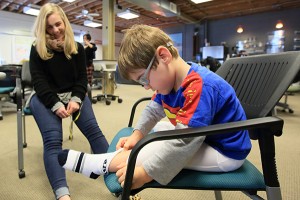
That idea was embraced by the product development expertise of Spectrum Health Innovations and the creative talents of a group of young fashion designers, and the result was custom outfits for kids with special needs.
The recent DisArt Fashion Show hosted at Kendall College of Art and Design featured the outfits that combine fashion and function. They were designed by Kendall student designers for children whose physical challenges include neuromuscular disorders such as cerebral palsy and the effects of cancer.
The show was part of the two-week DisArt Festival, the largest disability arts festival in the nation.
But the road to the runway began last year when Spectrum Health Helen DeVos Children’s Hospital physical therapist Robin Fisher decided there had to be a better way to help her patients replicate the effects of therapy at home.
The challenge
Cerebral palsy affects the brain and muscles and results in muscle weakness, poor motor control, shaking of the limbs and muscle stiffness.
Fisher and other pediatric physical therapists use therapeutic tape during therapy to influence certain muscle groups, and to align bones and muscles. Therapists also use special, customizable clothing similar to compression garments worn by athletes.
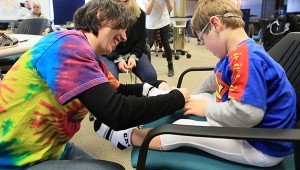
She notes that current specialty clothing is expensive, difficult to get on and off, uncomfortable, and doesn’t always replicate the effects of therapy. The challenge for designers is finding the right balance between form, function and design.
“My idea behind it was to make the clothes more comfortable for kids to wear, especially when it’s hot out, and also to make them more functional and more affordable for families,” Fisher said.
Enter Spectrum Health Innovations
With more than 21,000 employees, Spectrum Health’s physicians and staff like Fisher often identify opportunities for better ways of providing care, reducing costs, and improving the patient experience.
When they do, they can connect with Spectrum Health Innovations, a service for employees focused on health care entrepreneurship–moving ideas from concept to reality in an agile, resourceful and financially viable manner.
The Innovations team offered expertise in helping Fisher evaluate the problem, identify possible solutions and assess product feasibility. But that was just the beginning; knowing which experts and resources her project needed was crucial. The team used its network of connections to link Fisher to external resources such as therapeutic product manufacturers, materials specialists and designers.
“I wouldn’t have known where to begin,” said Fisher of her experience with the Innovations team. “They had the reach to hook up with companies and other collaborators and experts who could get us rolling.”
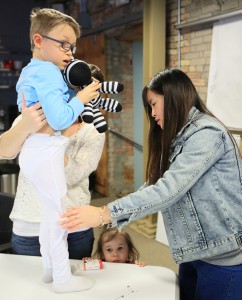
Fisher worked through initial ideas and concepts with parents, another physical therapist and the occupational therapy staff. Parents wanted ease of use, offering advice on what they would change based on current garments on the market. Suggestions included longer shirts that stay tucked in, making it easier to change diapers, and using lightweight fabrics that are cool in the summer.
The designs were refined and the project moved into material selection. Kendall students created patterns and sewed prototypes. Patients in the therapy program at Helen DeVos Children’s Hospital tested a prototype for shorts, and the Kendall designers worked on additional garments.
“It’s been a great collaborative experience,” Fisher said. “The Innovations team is an advantage of a larger health system like Spectrum Health. They know the ins and outs of the business and the legal side of something like a clothing business.”
The partnership grows
The partnership with Kendall College students grew even more comprehensive in the fall of 2014, when Lori Faulkner, the chairwoman of the fashion studies program, designed a class called Garments for Action and Function and hired an adjunct professor, Liz Bartlett, to teach it.
For their fashion show designs, Bartlett’s students use compression fabric, which stretches four ways and is anti-microbial stain resistant. But another important ingredient is fun.
“If a kid is into Mickey Mouse or Frozen, we want to incorporate that into the design,” Bartlett said. “When I first told my students last semester about this opportunity with Spectrum Health and kids who need garments, their eyes lit up.”
One of those students is Audrey Langejans. Her design for 3-year-old Matthew Twilling incorporated elements of his family’s favorite football team, the Green Bay Packers.
“I really like to put a face to one of my designs and finally have an actual consumer profile,” Langejans said. “It’s really awesome to make something fully functional, and for a kid who really needs it, and for kids in the future, if this takes off.”
Helping Matthew and other children to walk
Matthew was one of three triplets born prematurely at 27 weeks. All three received a diagnosis of periventricular leukomalacia, a brain injury that involves the death of small areas of brain tissue around fluid-filled areas called ventricles. The damage creates “holes” in the brain, and can lead to the development of cerebral palsy.
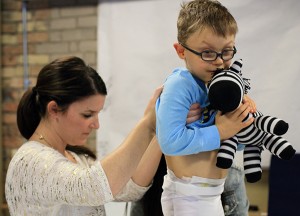
The disease has limited his mobility. He learned how to crawl at age 2, and only recently began to walk at 3 ½.
Matthew’s mom, Jen Twilling, said she and Matthew were unhappy with the specialty garments Matthew wore prior to the collaboration.
“We called them his Richard Simmons pants,” Twilling said. “They pushed his legs together so much and he doesn’t like to be confined. He wasn’t tolerating them.”
“Anything that could have sped up that process of walking and crawling would have been a great thing,” she said.
The challenge for Langejans was to provide compression in Matthew’s hips so that he can walk with straight legs, but also to avoid a bulky, unnatural fitting garment.
“Part of my design is creating a two-way stretch band to support the hips and hinder jolting in his hips,” Langejans said. “But you don’t want them to feel like they are being used for medical reasons. You want them to feel like it’s just a normal garment they are wearing.”
Matthew’s reaction at the first fitting exceeded her expectations.
“When I finally got him to wear the pants, he almost forgot about them,” she said. “He put them on and ran all over the place and just forgot he was wearing them.”
“Actually meeting the patients and working with them and watching them move has been a meaningful and beneficial thing for me as a designer,” Langejans added.
Next steps
The fashion show was a wonderful stop on a long road of therapy for many, but the road for product development may be an even longer one.
Further testing would ensure that a prototype garment achieves the same results as taping: realigning bones, joints and muscles to reduce pain and the breakdown of joints, and helping patients to avoid surgery and decreased mobility that often come with the condition.
Testing likely would go beyond fit testing to include gait testing, which evaluates walking patterns. The gait study would help determine if there are additional design issues that need improvement.
Initial estimates show that these custom outfits could come to market at a lower cost than existing garments, which run in the hundreds of dollars with customization. But finding an investor for a product that may have a limited market could be a challenge.
For now, the children, their families, and everyone connected with the project have a night they won’t soon forget, the satisfaction of being part of an important initiative, and the hope for a next generation of better-fitting, more practical and useful therapeutic garments.
Susan Walter contributed to this report.
 /a>
/a>
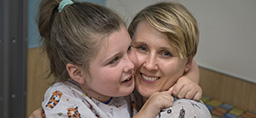 /a>
/a>
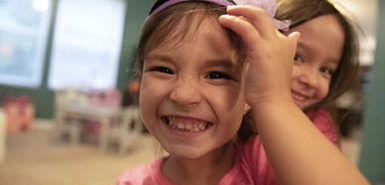 /a>
/a>
Great work!! So proud of the SH Innovations team – you are the best.
Thanks, Linda! Feel free to share this story and Health Beat with your friends! 🙂
Yes I did